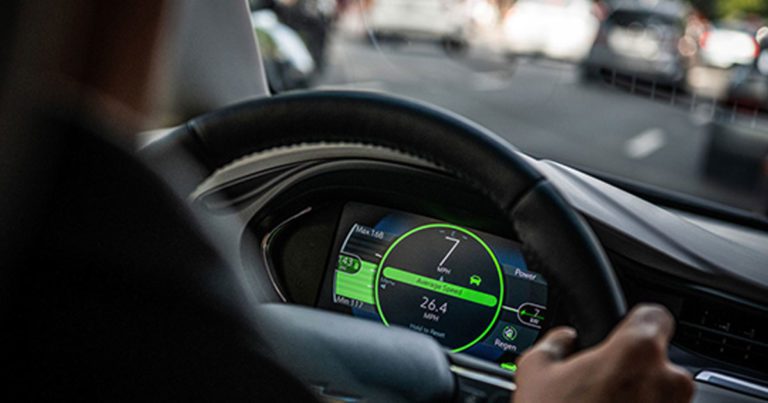
Driving an EV may take a little getting used to. We’ve gathered some helpful information to educate you and your drivers on successful EV operation.
Policy and Pick Up
- Update your fleet policy to include expectations on EV operation including charging.
- Schedule an online training course before they pick up their vehicle.
- Encourage drivers to take a test drive at the dealership from which they will be picking up their vehicle.
- Read the vehicle manual.
- Get comfortable driving the vehicle in an empty parking lot.
Safety
All EVs must meet the same Federal Motor Carrier Standards and Canada Motor Vehicle Safety Standards — and undergo the same rigorous safety testing as ICE vehicles. EVs also meet the electrical and safety standards set by the Society of Automotive Engineers, the National Electric Vehicle Infrastructure Working Council, and others.
Plug-in vehicles have built-in safety mechanisms to protect drivers and first emergency responders in case of accidents. First responders are trained on protocols for handling accidents involving plug-in vehicles. Below are some important safety-considerations when driving an EV versus an ICE vehicle:
- Faster acceleration: EVs accelerate more quickly from a stopped position than an internal combustion engine.
- Noiseless motors: Electric motors are extremely quiet, which can pose a danger to pedestrians and bicyclists who use engine noise to detect danger. Most government safety agencies are now requiring that EVs be equipped with electric vehicle warning sounds.
- One pedal driving / braking: To maximize energy utilization, EVs are equipped with a feature called One Pedal Control, the accelerator pedal controls both speeding up and slowing down. Pressing this pedal makes the vehicle move as usual but lifting the foot makes it slow down, hard, not coasting.
EV Charging vs. Fueling
It is important to take time to understand the different behaviors that come with fueling versus charging. Typically, when an ICE engine needs a fill up, it is easy to quickly locate a fueling station. And often, many wait until the last minute to refuel. But that same behavior doesn’t apply when operating an EV. While public charging stations are becoming more prevalent, it may take a little more time to locate one. In addition, if a battery is depleted, it can take from 30 minutes (with DC Fast Charge) up to more than a day (with Level 1 charging) to recharge it. Below are a few tips to help ensure your EV fleet is powered for the day and beyond.
- Plug it in: Be sure the vehicle is plugged in wherever it “sleeps” at night.
- Keep it charged: Batteries charged at a level between 20% to 80% extends their life and keeps them operating at peak efficiency.
- Don’t charge to 100%: Fully charging an EV reduces the regenerative braking and can degrade the battery.
- Switch up your charging methods: Sole use of fast chargers has a negative effect on battery health.
- Know where to charge: When planning a trip, make sure there is a mechanism in place (such as an app) to easily locate a charging station.
EV Range Optimization with Regenerative Braking
Regenerative braking is a cool technology. It uses an EV’s motor as a generator to convert the energy lost during deceleration back into the vehicle’s battery. The converted electrical energy is stored in the vehicle’s batteries, which can extend mileage range by 10 to 30%. Each driver and vehicle will experience different results.
The key influencing factors to increase the power of regenerative braking are as follows:
- Efficiency: This refers to the efficiency of how a vehicle’s regenerative process captures the energy from braking. Most vehicles are 60 to 70% efficient, losing 30 to 40% in the braking and reacceleration process.
- Driving conditions: Braking more often in ‘Stop and Go’ traffic creates more regenerative energy than highway driving.
- Terrain: Most drivers use more of their brakes when traveling downhill and on curved roads, while driving uphill or straight uses less braking. More braking equals more regenerative energy.
- Vehicle size: The larger the vehicle, the more energy is required to stop, which translates into greater regenerative energy.
- Use of Climate Control Features: The heating and air conditioning unit uses the same battery source as the vehicle. Using the air conditioner or heat while driving can reduce mileage range by 15 to 35%.
- Weather: When possible, avoid extreme temperatures — both extremely hot and cold temperatures negatively affect battery performance. Most EVs offer adequate auxiliary cooling and heating options.
EV Maintenance
While EVs are less expensive to maintain and more efficient to repair, you will still need to keep up a regular preventive maintenance schedule. Here are some key maintenance related differences:
- Electric Motors: Electric motors do not need the same level of maintenance as an ICE engine. Electric motors have fewer parts and no oil and fuel filters.
- Powertrain: The direct-drive or multi-speed transmission of an electric vehicle may require a fluid change.
- Brakes: Electric vehicles still have friction brakes, and the brake fluid and individual components, such as the pads and rotors, will eventually require replacement.
- Cooling: To keep key electrical components from overheating, most EVs use coolant or refrigerant to cool the likes of the charger, inverter, and battery pack. Infrequent coolant flushes or refrigerant recharges may be required.
- Tires: Tires on electric vehicles wear out just like those on an ICE vehicle and will need to be rotated and replaced.
Looking for more EV tips?
Check out the Wheels Mobility Guide: EV Edition.